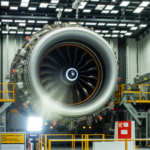BOSTON- GE Aerospace has successfully completed its initial round of GE9X dust-ingestion tests in 2022. The tests involved 1,600 engine run cycles and reported no negative outcomes.
This series of tests forms part of the company’s strategy to prepare the 105,000 lb-thrust GE9X engine, which will be utilized in the Boeing’s long-awaited 777-9 aircraft, set for customer delivery next year.
GE Engine Testing Phase
On May 28, GE announced it was nearing the completion of the second round of GE9X dust-ingestion tests, which builds on the evaluations from 2022.
The GE9X is the first powerplant that has undergone dust-ingestion tests prior to its service entry, highlighting the company’s heightened commitment to durability following recent reliability concerns affecting both GE and competitor engines, as noted by Flight Global.
To address concerns about durability, GE’s enhanced testing protocols particularly focus on engines operating in dusty and arid environments, such as the Middle East.
The company has also recently introduced durability improvement kits for the CFM Leap-1A turbofans, which are used in Airbus A320neo-family aircraft. These kits are designed with upgraded high-pressure turbine blades and nozzles.
Safran CEO Olivier Andries remarked in 2023 that Leap engines have encountered significant challenges in harsh environmental conditions, particularly in regions like the Gulf and India.
Design Modifications
GE has also created similar improvement kits for the Leap-1B engines that power Boeing’s 737 Max. This includes implementing design alterations to mitigate dust and sand-related durability challenges that have impacted its GEnx and GE90 engines.
The modifications affected components, such as shrouds, nozzles, blades, and combustor linings.
According to GE’s senior executive director of research, Joe Vinciquerra, the company initially had limited insights into the makeup of dust materials and how they interact with the intricate material systems used in engines.
Advanced Testing
GE now recreates dust conditions in controlled environments to conduct tests that mimic the real-world operating conditions of engines, allowing engineers to address durability issues effectively.
During the development phase, GE subjected the GE9X engine to 27,000 simulated flight cycles and 17,000 hours of operational testing.
Last year, GE began delivering production-conforming GE9X engines to Boeing and plans to ramp up production in the latter half of this year.
Competitor Responses
The durability challenges faced by GE are mirrored by its competitors, all of whom are allocating more resources to tackle these issues.
Pratt & Whitney continues to address widespread issues with its PW1000G geared turbofan family, while Rolls-Royce is implementing durability upgrades for its Trent engine variants.
Rolls-Royce’s durability enhancement plan for Trent 1000 engines aims to prolong the life of high-pressure turbine blades and to double the service intervals between maintenance checks. Improvements for Trent 7000 and Trent XWB-97 engines include redesigned components and optimized combustor performance.
Stay connected with us for ongoing updates. Additionally, you can join our Telegram Group for the Latest Aviation Updates and follow us on Google News.

Based on an article from aviationa2z.com: https://aviationa2z.com/index.php/2025/06/10/ge9x-to-power-777x-will-undergo-dust-ingestion-test/?utm_source=rss&utm_medium=rss&utm_campaign=ge9x-to-power-777x-will-undergo-dust-ingestion-test



